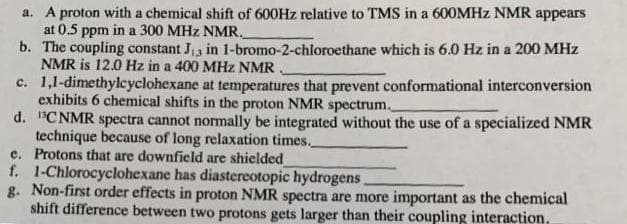Organic Chemistry: A Guided Inquiry
2nd Edition
ISBN:9780618974122
Author:Andrei Straumanis
Publisher:Andrei Straumanis
ChapterL3: Carbon (13c) Nmr Spectroscopy
Section: Chapter Questions
Problem 6CTQ
Related questions
Question
100%
True or False
please answer part B only

Transcribed Image Text:a. A proton with a chemical shift of 600HZ relative to TMS in a 600MHZ NMR appears
at 0.5 ppm in a 300 MHz NMR.
b. The coupling constant Ja in 1-bromo-2-chloroethane which is 6.0 Hz in a 200 MHz
NMR is 12.0 Hz in a 400 MHz NMR.
c. 1,1-dimethylcyclohexane at temperatures that prevent conformational interconversion
exhibits 6 chemical shifts in the proton NMR spectrum.
d. "CNMR spectra cannot normally be integrated without the use of a specialized NMR
technique because of long relaxation times.
e. Protons that are downfield are shielded
f. 1-Chlorocyclohexane has diastereotopic hydrogens
g. Non-first order effects in proton NMR spectra are more important as the chemical
shift difference between two protons gets larger than their coupling interaction,
Expert Solution
This question has been solved!
Explore an expertly crafted, step-by-step solution for a thorough understanding of key concepts.
Step by step
Solved in 2 steps

Knowledge Booster
Learn more about
Need a deep-dive on the concept behind this application? Look no further. Learn more about this topic, chemistry and related others by exploring similar questions and additional content below.Recommended textbooks for you

Organic Chemistry: A Guided Inquiry
Chemistry
ISBN:
9780618974122
Author:
Andrei Straumanis
Publisher:
Cengage Learning

Principles of Instrumental Analysis
Chemistry
ISBN:
9781305577213
Author:
Douglas A. Skoog, F. James Holler, Stanley R. Crouch
Publisher:
Cengage Learning

Macroscale and Microscale Organic Experiments
Chemistry
ISBN:
9781305577190
Author:
Kenneth L. Williamson, Katherine M. Masters
Publisher:
Brooks Cole

Organic Chemistry: A Guided Inquiry
Chemistry
ISBN:
9780618974122
Author:
Andrei Straumanis
Publisher:
Cengage Learning

Principles of Instrumental Analysis
Chemistry
ISBN:
9781305577213
Author:
Douglas A. Skoog, F. James Holler, Stanley R. Crouch
Publisher:
Cengage Learning

Macroscale and Microscale Organic Experiments
Chemistry
ISBN:
9781305577190
Author:
Kenneth L. Williamson, Katherine M. Masters
Publisher:
Brooks Cole